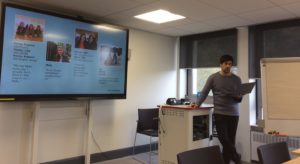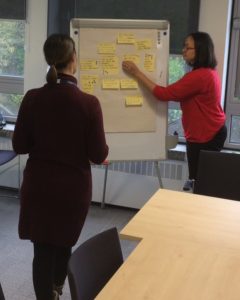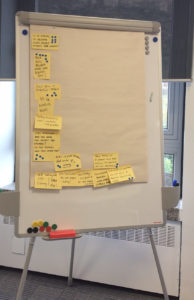Our first UX meetup – Letting the guerrilla loose
Yesterday we held the first of hopefully many lunchtime UX meetup sessions for colleagues interested in making websites, products and services for useful and user-friendly. We started with a seminar on guerrilla user research from Marty Dunlop, before spending 45 minutes in a lively debate of topics chosen by the group.
About the UX meetup
My aim with this group is to facilitate a greater feeling of community among colleagues interested in and undertaking user research and design work. I’m trying to create an informal forum where we can get together regularly to exchange ideas, get help and generally get to know each other a bit better.
So this session was the first of hopefully many. I’m looking forward to hear what the feedback is like, and find out where we can make improvements.
For now though, my plan is to:
- Get the group together roughly monthly
- Try different days and meeting times to see what people prefer
- Keep it relatively short – 90 minutes maximum
- Keep to a simple format that makes it easy to arrange:
- A guest speaker or a webinar of 30-40 minutes
- A group-agreed discussion agenda organised using the Lean Coffee approach (What’s Lean Coffee?)
If you’re interested in coming to a future event, sign up to the UX mailing list to be notified of future dates.
Join the UX mailing list (Edinburgh University login needed – hidden in the top left!)
Today’s presentation: Let the guerrilla loose
This was an introduction to guerrilla user research from one of our UX Consultants, Marty Dunlop.
Marty previously presented this at the UX Cambridge Conference in September 2017.
Presentation overview
Here’s what Marty had to say about his presentation:
“When time, money and even resource are a constraint, how can you still find the ability to conduct research and gather that vital insight?
The dictionary definition of ‘guerrilla’ refers to ‘actions or activities performed in an impromptu way, often without authorisation.’
When it comes to research, I like to think of it as ‘a proactive measure to take, embedded with your target user base, without a timesheet.’
Often, the research we want to do in order to validate an idea or gather further opinions doesn’t need to be anything more than an informal chat with a group that represents the target use base of your work.
With that in mind, why would worries about time and money be such decisive factors in whether or not the research ever takes place? The truth is they don’t need to be, but as you go deeper and deeper into the chain of command and request that time to do so, more and more people start looking for the justification or questioning actual need for the research at all.
However, think of this at a basic level; most likely you are the person with the greatest understanding of the value that research brings and that’s exactly why you are requesting it be conducted. When time and funds are tight, doing things formally is unlikely to get the go-ahead. Indeed, scheduling research becomes a deficit creating exercise in itself. Ultimately, the question to ask becomes: Is no user insight better than impromptu user insight?
So then, surely being able to conduct research cheaply, quickly and with minimal resource is a perfect solution? Bring in the guerrilla research method.
Simply put, this is an approach that prompts you to think on your feet and quickly connect with target users: in their own environment, with a few questions in mind, and a recording method to hand. (A notebook, dictaphone or a video camera – just whatever you have).
Choose an environment where you know that target user base frequents, schedule an hour into your diary (something that won’t be missed in your timesheet or can be covered in your own time), find any other willing colleagues to take part, agree just one or two simple yet open questions and then venture out and engage with people.
What you bring back from that small amount of invested time will be far greater than not having done a single thing. What you will also quickly discover is that we’re all human and we like to communicate. Providing there isn’t a catch (such as signing up to a service or establish a monthly direct debit to a charity cause) the people you approach will most likely be open to answering your questions.
Keep it simple, ask questions and be ready to listen. Most people are willing to talk about their experiences.”
UX discussion
Following Marty’s presentation, we set our discussion agenda and prioritised what we talked about together using the Lean Coffee approach.
This approach to discussion facilitation was new to almost everyone and was really well received.
Lean Coffee facilitator’s guide by Phillip Rogers on Medium.com
In a nutshell, here’s what we did:
- Everyone thinks of a few UX-related things they would like to discuss, one idea per post it note
- We review, group, clarify and de-duplicate the items as we stick them to the wall
- We all get 3 dot votes each
- The top prioritised items each get 5 minutes discussion (timed)
- At the end of each 5 minute segment the group votes whether to stay with this topic (thumbs up), move to next topic (thumbs down) or say they’re ambivalent (thumbs sideways).
On this basis, we organised our agenda and got through three items in about 40 minutes.
The top items for discussion were:
- Is it ethical to observe users/people without their consent?
- How do we avoid doing research that others have already done?
- Tips for getting students to participate in user research
Join the UX mailing list for future sessions
If you’re interested in coming to a future event, sign up to the UX mailing list to be notified of future dates.
Join the UX mailing list (Edinburgh University login needed – hidden in the top left!)
Were you there? What did you think?
Please leave a comment and tell us what you thought of the session.





I appreciated experiencing the Lean coffee method. Many meetings could do with such a mechanism to reinvigorate discussion and debate.
I wonder if it’s bound to be a once-in-a-while practice, or it might induce participant fatigue if used every or almost every time.
After all, pop-up research might well be like “Pop Art (…): popular, transient, expendable, low-cost, mass-produced, young, witty, sexy, gimmicky, glamorous, and Big Business” (Richard Hamilton)
The ‘transient’ and ‘expendable’ seems really key here, especially in relation to the top discussion item #2.
Pop-up research is not meant to be recorded/documented/archived beyond the project life,
otherwise it pushes the research beyond the pale of what pop-up research is all about,
i.e. busting lots of assumptions, with little resource at hand.
(In other words, every research is new research, and therefore has not been done before; browsing a research repository will neither be pop-up nor user-centred.)
Thanks Guillaume.
Re: Lean Coffee, personally I’d like to see it happen every meetup. But like you say, if it begins to get a bit tired then we’ll need to change. This is meant to be a community meetup after all, so it’ll go where the community needs it to.
Re: Pop-up research and re-using research. I agree, there’s a big difference between properly planned and resourced work and just getting out of the office for quick insight. One element of metadata we’ll definitely need in any research insight bank we establish will be a measure of strength of evidence, or robustness of approach.
Hope to see you next time!
I really enjoyed this session. Marty’s presentation was a great reminder that research doesn’t need to be resource-intensive and that any insight is better than no insight.
This was my first experience with the Lean coffee approach, and I found it a very interesting way to hold a discussion. The agenda is agreed democratically with the trusted dot-voting method. The simple voting mechanisms built into the Lean coffee method ensured we discussed the most relevant topics, and we moved on quickly when the conversation began to run out of steam. I thought the regular 5 minute segments helped keep the discussion relevant, focused, and well-paced.
I echo the sentiments about lean coffee- it’s a great discussion format, keeping the conversation focused and concise.
I especially enjoyed the discussion on how to avoid duplicating research, which brought some interesting questions and ideas to the table. For example, it was suggested all projects should begin by doing some gap analysis: what research has already been conducted and where are the gaps? This is exactly what UoE academics do with their research projects; we need to place more emphasis on this for those of us in professional services.